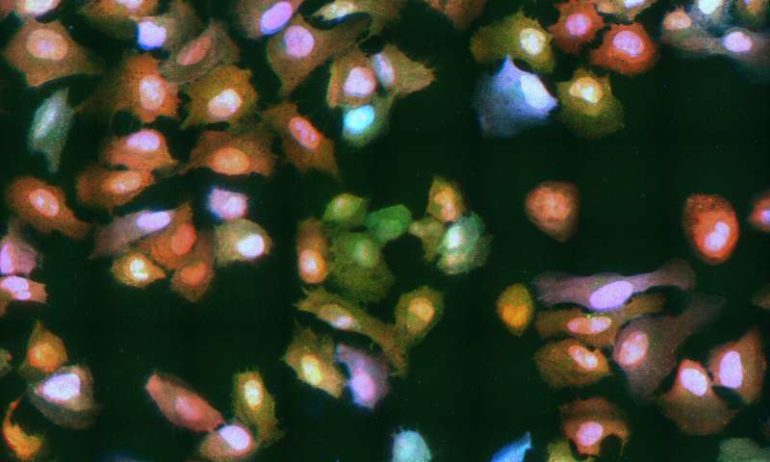Researchers from the Hubrecht Institute and Utrecht University have developed an advanced technique to monitor a virus infection live. The researchers from the groups of Marvin Tanenbaum and Frank van Kuppeveld expect that the technique can be used to study a wide variety of viruses, including SARS-CoV-2—the virus responsible for the current pandemic. The technique named VIRIM (virus infection real-time imaging) is therefore very valuable for gaining insights in virus infection in the human body. Eventually, this could lead to more targeted treatments for viral infection. The results were published in the scientific journal Cell on the 13th of November.
Viruses have a large negative impact on society. This is demonstrated once again by the enormous consequences of the current global outbreak of SARS-CoV-2 for individual physical and mental health and for the economy.
Intruder
RNA viruses represent a large group of viruses that carry their genetic information in the form of RNA, a molecule that is similar to DNA. After infection of a host cell, an RNA virus hijacks many of the host cell’s functions and turns it into a virus-producing factory. This way, the intruder can quickly replicate inside cells in the body. The new virus particles are subsequently released through the respiratory tract and can infect other people. Examples of RNA viruses include coronaviruses, the hepatitis C virus, the Zika virus and enteroviruses—a group of viruses that includes rhinoviruses, causing the common cold, coxsackieviruses, a cause of viral meningitis and encephalitis, and the poliovirus, which causes paralytic poliomyelitis.
Until now, available techniques could only provide a snapshot of virus-infected cells. In other words, researchers could see the infected cells at a certain point in time, but it was not possible to monitor the process of virus infection from beginning to end. The newly developed microscope technology VIRIM changes that: researchers from the groups of Marvin Tanenbaum (Hubrecht) and Frank van Kuppeveld (Utrecht University) developed this advanced method with which the entire course of a virus infection can be visualized in the lab with great precision. “This new method enables us to address many important questions about viruses,” says Sanne Boersma, first author of the study.
Fluorescent virus
The method uses SunTag—a technology previously developed by Tanenbaum—in an enterovirus, a group of viruses in which Van Kuppeveld has extensive expertise. The SunTag is introduced into the RNA of the virus and labels viral proteins with a very bright fluorescent tag. Using this fluorescent tag, viral proteins can be seen using a microscope, allowing researchers to see when, where and how quickly a virus produces it proteins and replicates in its host cell. VIRIM is much more sensitive than other methods: protein production from a single viral RNA can be detected. This allows researchers to track the course of the infection from the very beginning.
Competition
Cells have their own defense system to detect and eliminate a virus upon infection. Once a virus enters a cell, a competition arises between the virus and the host cell: The virus aims to hijack the cell to replicate itself, while the host tries very hard to prevent this. Using VIRIM, researchers were able to see the outcome of this competition. They found that in a subset of cells, the host cell won the competition. Boersma: “These host cells were infected by a virus, but the virus failed to replicate.” This triggered the curiosity of Boersma and her colleagues and led to a new experiment.
Achilles’ heel of the virus
The researchers helped host cells by boosting their defense system. As it turned out, the very first viral replication often failed in the cells that had received the boost, which prevented the virus from taking over the host. “The first step in the replication process is the Achilles’ heel of this virus: This moment determines whether the virus can spread further,” Boersma explains. “If the host cell does not manage to eliminate the virus at the very beginning of an infection, the virus will replicate and win the competition.” Boersma and her colleagues used a picorna virus for the development of VIRIM. Members of this virus family can cause diseases ranging from the common cold to severe diseases such as Polio.
VIRIM enables the identification of the vulnerable phases of a wide variety of viruses. The researchers expect the technique to be valuable for research into many life-threatening viruses, including SARS-CoV-2. Boersma explains: “Understanding viral replication and -spreading can help us determine the Achilles’ heel of a virus. This knowledge can contribute to the development of treatments, for example a treatment that intervenes during a vulnerable moment in the virus’ life. That allows us to create more efficient therapies and hopefully mitigate the impact of viruses on society.”
How picornaviruses enter the host cell
More information:
Boersma et al., Translation and replication dynamics of single RNA viruses. Cell (2020). DOI: 10.1016/j.cell/2020.10.019
Provided by
Hubrecht Institute
Citation:
Researchers develop virus live stream to study virus infection (2020, November 13)
retrieved 15 November 2020
from https://phys.org/news/2020-11-virus-stream-infection.html
This document is subject to copyright. Apart from any fair dealing for the purpose of private study or research, no
part may be reproduced without the written permission. The content is provided for information purposes only.



